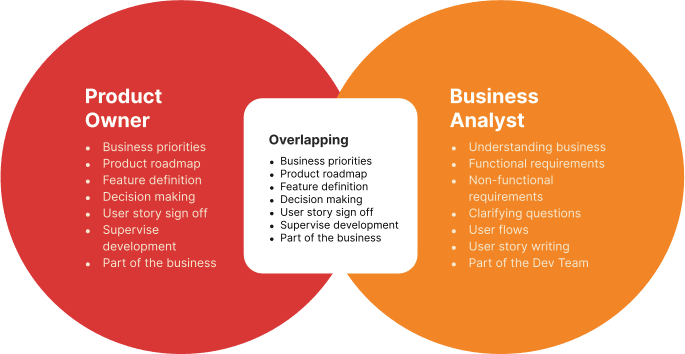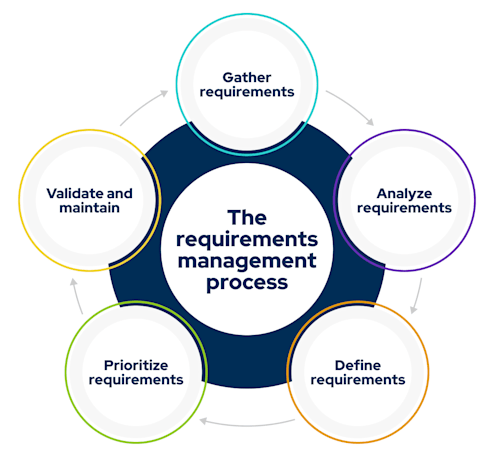
- Role Definition of Product Owner vs Business Analyst
- Key Responsibilities of Product Owner vs Business Analyst
- Stakeholder Interaction
- Decision-Making Authority
- Requirements Management
- Difference Between Product Owner and Business Analyst
- Agile Framework Perspective
- Collaboration with Scrum Teams
Role Definition of Product Owner vs Business Analyst
The roles of Product Owner vs Business Analyst are often confused in Agile environments, but they serve distinct purposes. The Product Owner is responsible for the vision, strategy, and overall success of the product. They act as a liaison between stakeholders and the development team, ensuring the product meets business goals and user needs. The Business Analyst, on the other hand, focuses more on understanding the business requirements, gathering detailed specifications, and ensuring those requirements are communicated to the development team. The difference between a Product Owner and a Business Analyst lies primarily in their focus: the Product Owner prioritizes the product backlog, making strategic decisions about what features to develop next, while the Business Analyst dives deeper into the details of those features, ensuring they align with business needs. Individuals looking to excel in this role can benefit greatly from Business Analyst Training, which equips them with the skills to bridge the gap between business requirements and technical implementation effectively. During Agile Sprint Planning, both roles collaborate, with the Product Owner presenting the overall goals and priorities and the Business Analyst providing detailed insights to support the technical implementation. While their responsibilities may overlap, their areas of focus are key to driving the success of an Agile team, with the Product Owner steering the product vision and the Business Analyst ensuring that the business needs are effectively translated into actionable requirements.
Are You Interested in Learning More About Web Developer Certification? Sign Up For Our Business Analyst Online Training Today!
Key Responsibilities of Product Owner vs Business Analyst
- Vision and Strategy: The Product Owner defines the product vision and overall strategy within the Agile Framework, ensuring the product aligns with business goals and user needs. In contrast, the Business Analyst focuses on refining specific requirements that help shape the product’s features.
- Product Backlog Management: The Product Owner is responsible for creating and prioritizing the product backlog, deciding which features and functionalities should be developed. The Business Analyst, however, may assist by providing detailed requirements for these features. Why Business Analysts Are Important in business lies in their ability to ensure that business needs are accurately captured, enabling the development team to deliver solutions that align with organizational goals and drive value.
- Stakeholder Interaction: The Product Owner frequently communicates with stakeholders, gathering input and feedback to make strategic decisions. The Business Analyst works closely with stakeholders as well but tends to focus more on capturing detailed business requirements and ensuring their proper implementation.
In Agile environments, the roles of Product Owner vs Business Analyst are crucial for ensuring the successful delivery of a product. While both roles collaborate closely, their core responsibilities vary, each contributing uniquely to the development process. Here are six key responsibilities that distinguish the Product Owner from the Business Analyst:

- Decision-Making Authority: The Product Owner holds significant decision-making authority, especially regarding what features are prioritized in the backlog and which release strategies to adopt. The Business Analyst typically does not make these high-level decisions but plays a key role in ensuring that business needs are clearly defined.
- Collaboration with Scrum Teams: The Product Owner works closely with the Scrum Teams, ensuring that the team’s work aligns with the product vision and goals. The Business Analyst collaborates with Scrum teams to clarify requirements, remove roadblocks, and ensure the team understands the specifications.
- Iteration and Feedback: The Product Owner ensures the product evolves iteratively, continuously incorporating feedback from stakeholders. The Business Analyst contributes by ensuring that each iteration’s deliverables meet the agreed-upon business requirements and standards.
- Product Vision and Strategy: The Product Owner has the primary decision-making authority when it comes to defining the product vision and strategy. This is crucial in the Agile Framework, where the Product Owner ensures that the product roadmap aligns with business objectives and user needs.
- Prioritizing the Product Backlog: The Product Owner sets priorities in the product backlog, deciding what features or user stories to develop based on stakeholder needs, market trends, and strategic goals. For those interested in data-driven careers, Business Intelligence is the Best Career Option, offering opportunities to influence business strategies.
- Feature Prioritization: The Product Owner vs Business Analyst distinction lies in their decision-making power. While the Business Analyst gathers and defines requirements, the Product Owner ultimately decides which features will make it into the product, ensuring alignment with broader business goals.
- Stakeholder Interaction: The Product Owner has the final say in decisions regarding stakeholder input and feedback. They are responsible for balancing stakeholder demands and the product’s vision, whereas the Business Analyst ensures that these requirements are properly documented and understood.
- Sprint Planning Decisions: In Agile Sprint Planning, the Product Owner plays a pivotal role in determining which items will be included in the sprint, based on their priority. The Business Analyst supports this process by providing detailed requirements, but the final decision rests with the Product Owner.
- Scrum Team Alignment: The Product Owner guides the Scrum Teams by making decisions on the product backlog and ensuring the team works towards delivering the highest-value features first. The Business Analyst works with the team to clarify requirements and remove obstacles but does not have the same level of decision-making authority in terms of prioritizing features.
Stakeholder Interaction
Stakeholder Interaction is a crucial aspect of both the Product Owner vs Business Analyst roles, but their approaches differ. The Product Owner serves as the primary point of contact for stakeholders, ensuring their needs, expectations, and feedback are incorporated into the product’s development. They engage with stakeholders regularly to understand market demands, business goals, and user feedback, then translate these into actionable product features. In contrast, the Business Analyst interacts with stakeholders to gather and clarify detailed requirements, ensuring that the business needs are fully understood and communicated to the development team. While the Product Owner focuses on high-level objectives and priorities, the Business Analyst dives into the specifics, capturing functional and non-functional requirements. The difference between Product Owner and Business Analyst lies in the level of interaction. Product Owners have more strategic conversations with stakeholders, while Business Analysts focus on tactical, detailed conversations. Developing Lead Business Analyst skills is crucial for those looking to take on more responsibility, as it involves mastering the art of gathering, analyzing, and documenting requirements while ensuring clear communication between business and technical teams. Both roles work together during Agile Sprint Planning to ensure alignment between business needs and development efforts, with the Product Owner guiding the vision and priorities and the Business Analyst ensuring that stakeholder requirements are accurately represented in the sprint backlog. Effective stakeholder interaction ensures both roles can guide the product towards its intended goals while maintaining stakeholder satisfaction.
Are You Preparing for Business Analyst Jobs? Check Out ACTE’s Business Analyst Interview Questions & Answers to Boost Your Preparation!
Decision-Making Authority
In Agile environments, understanding Decision-Making Authority is essential for distinguishing the roles of Product Owner vs Business Analyst. While both roles collaborate closely, their levels of authority and decision-making influence differ, impacting the product development process. Below are six key points highlighting the differences in decision-making authority between the two roles:
Are You Considering Pursuing a Master’s Degree in Business Analyst? Enroll For Business Analyst Masters Program Training course Today!
Requirements Management
Requirements Management is a key responsibility in Agile projects, and the roles of Product Owner vs Business Analyst play distinct parts in this process. The Product Owner is responsible for defining the high-level product vision and prioritizing the product backlog, ensuring that the most critical features are delivered first. They focus on aligning the product’s direction with business goals and stakeholder needs. In contrast, the Business Analyst dives deeper into the details, gathering, documenting, and refining requirements from stakeholders, ensuring that these requirements are clearly understood and feasible for the development team. Those interested in mastering these skills can benefit from Business Analyst Training, which provides the tools and techniques necessary to effectively manage stakeholder expectations and translate business needs into actionable requirements. The Difference Between Product Owner and Business Analyst in requirements management lies in the scope and depth of their involvement: the Product Owner prioritizes and maintains the backlog, while the Business Analyst ensures that the requirements are properly captured, clarified, and detailed for implementation. During Agile Sprint Planning, both roles collaborate to ensure that the requirements are well-defined and aligned with the sprint’s goals. The Product Owner ensures the backlog is prioritized and ready for development, while the Business Analyst ensures the requirements are clear and actionable. Together, they ensure that the team has the necessary insights and clarity to deliver valuable product increments efficiently.

Difference Between Product Owner and Business Analyst
The Difference Between Product Owner and Business Analyst lies primarily in their focus, responsibilities, and decision-making authority within Agile teams. The Product Owner is responsible for defining the product vision, prioritizing the product backlog, and ensuring the development team delivers value to the business and users. They make strategic decisions about which features to build and how the product should evolve based on stakeholder input, market needs, and business goals. On the other hand, the Business Analyst focuses on understanding and detailing the specific requirements that drive product development. To support data-driven decisions, they often work with the Top Business Intelligence Tools to gather insights and ensure solutions align with business goals. They work closely with stakeholders to gather, document, and clarify business needs, translating these into clear and actionable requirements for the development team. While the Product Owner has decision-making authority over the product’s priorities, the Business Analyst plays a supporting role by ensuring that the product’s requirements are well understood and feasible. Both roles often collaborate during Agile Sprint Planning, with the Product Owner focusing on which features to prioritize and the Business Analyst ensuring the team has the necessary details to implement them effectively. In essence, the Product Owner drives the product vision, while the Business Analyst ensures the precise details and requirements are met.
Agile Framework Perspective
From an Agile Framework perspective, the focus is on delivering value through iterative development, collaboration, and flexibility. The framework emphasizes continuous improvement, with teams working in short, time-boxed iterations called sprints, typically lasting two to four weeks. Central to Agile is the Product Owner vs Business Analyst distinction, where the Product Owner sets the vision, prioritizes the product backlog, and ensures the team is working on the highest-value features. Meanwhile, Business Analysts may use tools like Tableau to analyze requirements skills such as how to Create a Donut Chart in Tableau can help visualize data and support better decision-making. The Business Analyst, however, plays a crucial role in helping the team understand and refine requirements, ensuring that they are clear and actionable for the developers. This collaboration is key in Agile, as it ensures that both strategic goals (driven by the Product Owner) and detailed requirements (clarified by the Business Analyst) are aligned. The Agile framework also encourages constant feedback from stakeholders to guide development and adjust priorities as necessary. This adaptability is essential, as it allows teams to respond quickly to changing market conditions and customer needs. By maintaining a focus on delivering small, incremental improvements, Agile ensures that the product evolves in the right direction, with both the Product Owner and Business Analyst collaborating closely to drive success and meet stakeholder expectations.
Are You Interested in Learning More About Business Analyst? Sign Up For Our Business Analyst Online Training Today!
Collaboration with Scrum Teams
Effective collaboration with Scrum Teams is vital for delivering value in an Agile Framework, where cross-functional teams work together iteratively to meet evolving business needs. Within this context, understanding the distinction between the Product Owner vs Business Analyst roles is crucial. While the Product Owner holds decision-making authority over the product backlog and prioritization, the Business Analyst often supports by refining requirements and enhancing communication across technical and business stakeholders. Strong stakeholder interaction ensures that the team builds the right product by maintaining transparency, shared goals, and continuous feedback loops. The Scrum Teams benefit from close collaboration with both the Product Owner and Business Analyst, as it fosters a well-groomed backlog, clear user stories, and alignment with business objectives. Professionals seeking to enhance their effectiveness in this collaboration can consider Business Analyst Training, which helps develop the necessary skills to bridge the gap between stakeholders and the development team. Regular ceremonies such as Sprint Planning, Reviews, and Retrospectives further reinforce this collaborative environment, allowing for adaptive planning and improvement. Ultimately, consistent engagement and clarity in roles contribute to the success of Agile delivery, enabling Scrum Teams to remain focused, empowered, and aligned with stakeholder expectations.




